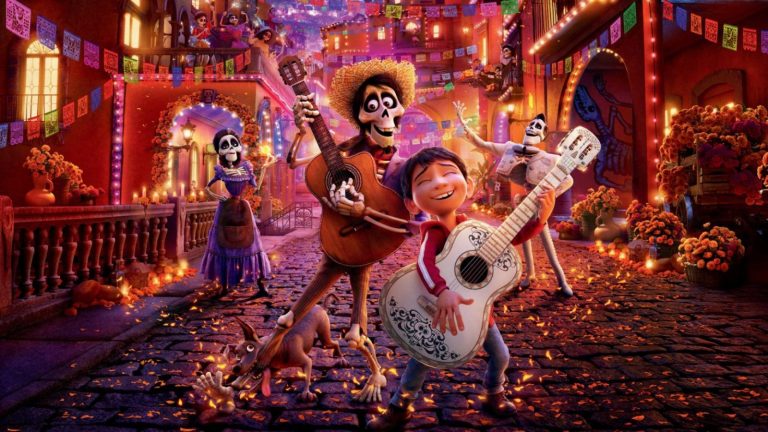We tend to think of the past as settled. There is nothing we can do to change it. But this is not entirely true. How we think about the past – the good guys and bad guys, the justice and injustice, the causes and effects – has a profound effect on our perceptions of the present. Our understanding comes to be revised based on new information as it comes to light. In this sense, the past is not settled. It is a living reality.
Big thoughts, right? They come to me courtesy of an animated film now rocking the theaters. I’ve felt for years that there is more genuinely adult content in the best of the movies made for kids than in most “adult” fare. The film introduces us into a land of the dead – neither time nor eternity – and raises the challenging idea that the dead, too, are still learning and changing.
Philosophy of History
This exciting story takes place on many levels. The movie in question is Pixar’s new animated feature Coco. It explores a realm of the culture, religion, and nationality of Mexico. It received its theatrical premiere in Mexico on the Día de Muertos (Day of the Dead), and was released to US audiences later. All the voice actors are Mexican.
This exciting story takes place on many levels. As soon as you think it is a feel-good tribute to family loyalty, it takes you to another place completely, to explore something as profound as the philosophy of history. This was the part that stunned me and left me thinking hard.
It follows the young life of Miguel Rivera, who feels the calling to be a musician but faces resistance from his family. His great-great grandfather was a musician who left his family to pursue a dream of becoming a great performer, writing music and singing for the world. His family was so bitter about his decision that two generations banned music from the household in favor of the family business of shoemaking.
But Miguel doesn’t want to be a shoemaker. He wants to sing and play music like his great-great grandfather. So on the Day of the Death, he makes his way to a monument to the famous singer Ernesto de la Cruz. He picks up the singer’s guitar and suddenly finds himself transported to another world entirely. It is the land of the dead.
Cool City
It turns out that the land of the dead is a happening place with great transportation systems, colorful apartment units, great places to eat and drink, and even pop stars and concerts. In order to get back to the land of the living, Miguel has to seek the blessing of an ancestor who resides there. He finds his great-great grandmother, but she will only give her blessing with the condition that Miguel decline to sing music. It’s an offer that Miguel cannot accept.
Once forgotten, the dead finally die and go away to nowhere in particular forever. Gradually we come to learn who lives in this place and why. It’s where you go when you die but the amount of wealth you possess and the length of time you get to stay there is entirely dependent on whether you are actively remembered by your survivors. The day when this takes place is the Day of the Dead, during which time mementos of one’s dead ancestors should be displayed so that they can continue to live it up in the land of the dead. Once forgotten, the dead finally die and go away to nowhere in particular forever.
That’s pretty harsh! And this is precisely why it is imperative that families continue to revere dead family members.
Here is where the drama gets interesting. Miguel decides to seek out another dead family member who can send him back to the land of the living without the annoying condition that he not sing and play. He seizes on the famous singer Ernesto de la Cruz, who he believes to be his real great-great grandfather. He is so well remembered among the living that Ernesto is extremely wealthy.
However, we gradually come to learn that he is something of a jerk. The people in the land of the dead come to learn this too, once they discover a hidden secret in his life. The popular image of this guy is shattered and he loses his fan base completely, which is a hilarious turn given that all these people are dead!
What Does this Mean?
This is where the philosophy of history comes to matter. The reputations of the dead are subject to change as both the living and the dead develop new opinions in light of new information. This ongoing learning process shifts culture and society in both the land of the dead and the living. What a remarkable tribute to the power of stories that we know and tell each other!
An example from real life might be someone like Woodrow Wilson. He was revered after his death as an intellectual, a great statesman, a bringer of peace, a prophet of democracy and nationalism. Today, matters are different. Wilson is known as a proponent of eugenics, a champion of the Klan, a hard-core racist, a tool of the ruling class, and a bringer of murderous and pointless war.
What a difference! And all of this while he lived in the land of the dead!
The past is not settled. It continues to live and, therefore, change. Or consider FDR. To this day, he is seen as the man who save us from the Great Depression even though he evidently did not. He is regarded as a champion of the downtrodden even though he was the architect of the corporate state that cartelized and locked down economic growth. And like Wilson, his views on matters of race and demographics trended white supremacist and exclusionary. When will FDR’s reputation change? Surely it is coming.
Or think of a president like Andrew Jackson. He is now seen as an opponent of the national bank and a champion of the people. But what happens when he comes to be seen as an exterminator of the native population, a demagogue who ran a corrupt presidency, and an unscrupulous pusher of military imperialism?
This could happen, but it depends on the people who dig up the facts and get them marketed to the population. The past is not settled. It continues to live and, therefore, change. And it changes our impression of the present.
Stealing Ideas
Coco offers other fascinating insight into the whole area of intellectual property and cultural appropriation. The big issue in the land of the dead concerns who precisely wrote the famous songs that Ernesto de la Cruz sings. He has always claimed credit, but is this correct? When the verdict changes, his reputation also changes.
I wondered at first if we were going to get a lecture on attribution rights from Hollywood, but this is not what it’s about. It’s about whether to respect the merely famous or the people who are the real creators. You can respect “creative rights” and the need for proper attribution without passing laws such as intellectual property.
As for cultural appropriation, the movie might at first seem to dabble in the current fashion for cultures to wall themselves off and protect their products from being “stolen” by others. Actually, and fortunately, there is nothing particularly “political correct” about this film. It is a straight up celebration of Mexican culture and the myths that have shaped it.
Who has appropriated whom? It runs both directions, as it always does when two cultures come in contact with each other. I recognized so much of this from my own childhood, when my best friend was a first generation child of immigrants from across the border. Their lives were so different from mine. That house across the street became a window into another beautiful world and served as a constant reminder that my family’s way was not the only way. I marveled at the Mayan calendar on the wall, the method that Mama Rede used to make nightly tortillas, the luxuriously Latinate language, and the family rituals.
To me, it was all so liberating.
Watching Coco, I was struck so hard by the magical way in which Mexican culture so beautifully blended two religious traditions, the faith of the Aztec heritage and European-style Catholicism, into a seamless whole. The Day of the Dead becomes All Souls, the need to remember our ancestors becomes prayers for the dead from Catholic liturgy, and the land of the dead is a proxy for Purgatory.
Who has appropriated whom? It runs both directions, as it always does when two cultures come in contact with each other. The bottom line is that there would be no such thing as a Mexican culture to celebrate had it not been for cultural appropriation. The movie Coco is so infectious that it would not surprise me if it inspires many young people to appropriate aspects of that culture for themselves.
As for its philosophy of history, the film is right: the past is never stable, nor should it be.
This article originally appeared on FEE.














Add comment